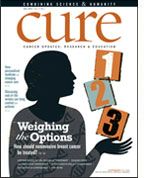Publication
Article
CURE
Sunburns During Teen Years Increase Melanoma Risk
Author(s):
Sun exposure during the earlier part of life, specifically in young white women, seems to be predictive of melanoma risk, according to a new study.
Melanoma is one of the fastest-growing cancers worldwide. Sun exposure during the earlier part of life, specifically in young white women, seems to be predictive of melanoma risk, according to a new study published in the journal Cancer Epidemiology, Biomarkers & Prevention.
For the study, researchers followed more than 100,000 Caucasian nurses for 20 years. Those who had at least five sunburns that caused blistering of the skin between the ages of 15 and 20 years old, had an 80 percent increased risk for developing melanoma.
Risk for non-melanoma skin cancers also increased but not as much. The study was conducted primarily through questionnaires about medical history, family history of melanoma and potential risk factors, including tanning bed use, blistering sunburns, smoking, alcohol use and weight.
Whereas cumulative exposure to ultraviolet rays resulted in an increased risk of non-melanoma skin cancer, adult exposure to UV rays was not found to necessarily increase a woman’s risk of melanoma. This led researchers to conclude that the physiology of melanoma and nonmelanoma skin cancers is different.
While there are no recommended routine screenings for skin cancer, it is important to note that risk factors include having a high number of moles, fair skin and red hair. Several blistering sunburns between the ages of 15 and 20 may now be added to that list, providing more specific prevention strategies for this population.





